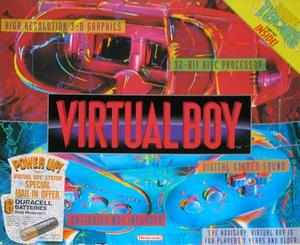6 Attempts at 3-D Gaming Before the 3DS
 |
?If you’ve managed to look at a Nintendo 3DS without your eyes hurting or exploding out of your skull, then maybe you feel like you’ve seen the future of videogame entertainment. But you’re actually also looking at the past, in a way. There have already been several attempts to mass market a 3-D gaming experience well before Nintendo released the 3DS in America last month.
Many of these you have already forgotten about, mainly because many were massive commercial failures and/or didn’t work very well. Or you might not have ever heard of them because you are obnoxiously young and your first system was an Xbox. Therefore, let me enlighten you with six of these storied devices that tried to make early gaming appear to have literal depth.
6) Virtual Boy
Remember when adding “Virtual” to something made it cool? No? Then you are remembering correctly. To show you how long Nintendo has had the idea of putting 3-D gaming in your hands, remember the much maligned Virtual Boy system, which came out in 1995. Running high on the fumes of the Super Nintendo, Nintendo execs must have been delirious when they came up with this thing. Using a console with built-in goggles and a standard controller, the 3-D effect actually worked pretty well… however, the graphics weren’t much better than the NES and, more importantly, they were all red. Red against a black background. It was like a world seen through Peckinpah-vision. In addition, the cost of the system at $180 made even the technophiles gawk. Nintendo killed the system less than a year after its release.
The above commercial proclaims the Virtual Boy a “3-D Game for a 3-D World.” Well, if the world was entirely red and gave you eyestrain, then yes.
5) Time Traveler
Time Traveler was an arcade game made by Sega. It claimed to use “Holographic” technology to create a 3-D image. In reality, what was going on was that you were looking down into a parabolic mirror with an image projected upon it in such a way as to create a sensation of depth.
The game itself was essentially a Dragon’s Lair-type affair, where you maneuvered a cowboy (yes, a cowboy) through time to save a girl. One wrong move and you were burned, zapped, or turned into a mushroom. It’s all the less exciting when you realize almost all the footage was live-action projected from a laserdisc.
4) Rad Racer
Rad Racer was essentially Outrun for the Nintendo Entertainment System and was cringe-worthingly displayed in the Fred Savage vehicle The Wizard, where Savage met a teen named Lucas who used a Power Glove to control the car on-screen. Alas, the actual game could not be controlled nearly so accurately with a Power Glove… NOR COULD HARDLY ANY OTHER GAME. Ahem. In any case, one additional feature of Rad Racer was a way to play the game in 3-D using your standard blue-red glasses and the NES generating an anaglyph image. The effect didn’t work so well, due to the limited color palette generating ability of the NES, so more often than not instead of getting 3-D graphics you just got a blurry screen and a headache.
3) SegaScope 3-D
SegaScope 3-D plugged into the Sega Master System and allowed for full-color 3-D by using flickering glasses synced with the images on the screen to achieve the dual-image effect. For 1988 this was quite high tech — in fact, similar technology is used for 3-D TVs in 2011. Its games included 3-D-ified versions of Sega hits like Out-Run, Space Harrier, and Zaxxon, to originals like Blade Eagle 3-D, a shoot-em-up against robots, and the 1980s appropriate Missile Defense 3-D, which made use of the light gun to shoot down Soviet missiles and save Capitalism. Just check you the awesome commercial! The action goes right in your face!
2) TomyTronic 3D
For those of you in your 30s, chances are your first experience with portable gaming probably came at the hands of a Tomy or Tiger Electronics LCD-based device. The TomyTronic 3D kicked it up a notch — they took an LCD game and merged it with a 3-D ViewMaster, so you looked through and controlled the game through a large set of goggles. There was image separation between two LCD images, creating a 3-D effect. The games were rather simple, such as “don’t crash the car into things” with Thundering Turbo, or “shoot planes” in Sky Fighters. The graphics were simple, and the sound was an even simpler series of bleeps and bloops. Still, if you had nothing else to compare it to, and you were 5 years old, it was awesome.
1) Vectrex 3D Imager
The Vectrex was a game system incorporated into a CRT that played exclusively vector-graphics games. The Vectrex 3D Imager was an add-on for Vectrex, and is so rare it almost costs more than the actual game system is was made for.
With the 3D imager you could take these simple polygons and extend them into the third dimension. The technique was a little unorthodox; it consisted a color wheel the size and shape of a CD, attached to a CD turntable, which itseld attached to a pair of goggles that then attached to your face. The spinning of the disc, tied with the flickering of certain images allowed, you to see certain images for a certain eye in a certain color — creating a 3-D effect.
When the SegaScope 3D was released and made the claim of being the first 3-D add-on for a game, Sega had to pull the ads when they realized that the Vectrex Imager came first.
Here is a very excellent YouTube video of the 3D Imager from user Techmoan, which goes so far as to record footage from an eye-view perspective.
